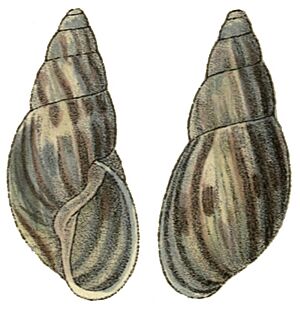Anthinus henselii facts for kids
Quick facts for kids Anthinus henselii |
|
|---|---|
 |
|
| Drawing of apertural and abapertural views of a shell of Anthinus henselii. | |
| Conservation status | |
| Scientific classification | |
| Kingdom: | |
| Phylum: | |
| Class: | |
| (unranked): |
clade Heterobranchia
clade Euthyneura clade Panpulmonata clade Eupulmonata clade Stylommatophora informal group Sigmurethra |
| Superfamily: |
Acavoidea
|
| Family: |
Strophocheilidae
|
| Genus: |
Anthinus
|
| Species: |
A. henselii
|
| Binomial name | |
| Anthinus henselii (Martens, 1868)
|
|
| Synonyms | |
|
|
Anthinus henselii is a type of land snail that breathes air. It is a gastropod mollusk, which means it's part of a group of soft-bodied animals like slugs and clams. This snail belongs to the family Strophocheilidae.
Sometimes, this snail is also called Drymaeus henselii. When it has this name, it's placed in a different group called the Bulimulinae subfamily, which is part of the Orthalicidae family.
The snail was first described in 1868 by a scientist named Eduard von Martens. He originally named it Bulimulus henselii. The name henselii honors Reinhold Friedrich Hensel. He was a German naturalist, paleontologist, and zoologist. Hensel collected the very first two snails that were used to describe this species.
This snail is found only in Brazil. Its original discovery spot, called the type locality, is Costa da Serra. This area is in the state of Rio Grande do Sul, which is the southernmost state in Brazil. It also lives in the state of Santa Catarina.
Contents
About the Anthinus henselii Snail
This snail is listed twice in the Checklist of Rio Grande do Sul State from 2009. It appears as Drymaeus henselii and also as Gonyostomus henselii. This shows how its classification can sometimes be a bit confusing for scientists!
What the Shell Looks Like
The shell of Anthinus henselii has a small hole at its base. It is shaped like an egg and is somewhat tall and pointed. The shell has uneven lines and very fine, close spiral patterns.
The shell is mostly whitish in color. It has brown streaks that blend together in the middle of each turn. The very top of the shell, called the apex, is blunt and brownish.
The shell has six turns, or whorls, which are fairly flat. The line where the whorls meet, called the suture, is wavy. The last and largest whorl, known as the body whorl, is slightly rounded at the bottom.
Shell Opening Details
The opening of the shell, called the aperture, is almost straight up and down. It's shaped like a long oval and is about half the length of the entire shell.
The edge of the opening, called the peristome, is a little thicker. It spreads out slightly and is white. The inner edge of the opening, the columellar margin, is wide. It does not close the small hole at the base of the shell. This margin also extends upwards into a thin plate. The central pillar of the shell, called the columella, is twisted.
Shell Measurements
- The total length of the shell is about 40 millimeters (1.6 inches).
- The width of the shell is about 28 millimeters (1.1 inches).
- The height of the shell's opening is about 20 millimeters (0.8 inches).
- The width of the shell's opening is about 11 millimeters (0.4 inches).


